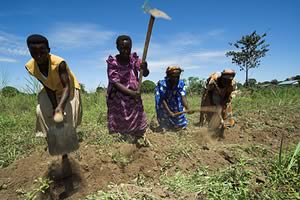 |
|||||||||
|
|||||||||||||||||||
|
|
Addressing Climate Change and Food Security Together 2009-12-01 Farming practices that capture carbon and store it in agricultural soils offer some of the most promising options for early and cost-effective action on climate change in developing countries, while contributing to food security, FAO said in a policy brief prepared for the Copenhagen summit.
Yet agriculture has been largely excluded from the main climate financing mechanisms under discussion in Denmark, the agency said. Agriculture not only suffers the impacts of climate change, it is also responsible for 14 percent of global greenhouse gas emissions. But agriculture has the potential to be an important part of the solution, through mitigation-reducing and/or removing a significant amount of global emissions. Some 70 percent of its potential for reducing emissions could be realized in developing countries, FAO said. "We hope the UN summit in Copenhagen will send a clear signal that agriculture in developing countries should play a vital role in responding to this global challenge," said Alexander Müller, FAO Assistant Director-General. "There are strong synergies between climate change mitigation, adaptation and food security that will be captured, if we do this right." The FAO policy brief being released today calls for funding to help "vulnerable" developing nations respond "more comprehensively to the dual challenges of climate change and food security." The brief said such support should reward actions aimed at reducing emissions and adapting to climate change, while also encouraging agricultural development and improved food security. The policy brief also suggested exploring synergies between Official Development Assistance (ODA) and new, additional climate funding. Part of the solution Food production will have to increase by 70 percent to feed an additional 2.3 billion people by 2050, FAO said. Climate change threatens agricultural production through higher temperatures and changes in rainfall patterns, and increased occurrences of droughts and floods, especially in areas that are already prone to climate-related disasters. Poorest regions with the highest levels of chronic hunger are likely to be among the worst affected by climate change, "Agriculture offers readily available and cost-effective options for reducing the emission of greenhouse gases, and can start to do so now," Müller said. "And climate financing mechanisms targeting agriculture could speed up efforts to reduce emissions and adapt to climate change, while helping to reduce hunger and poverty. " In contrast, he added, some other sectors may well require investments in expensive technologies and new, long-term research. Certain farming practices, including those used by organic and conservation agriculture, capture carbon and store it in soils. These include no/low tillage, utilizing residues for composting or mulching, use of perennial crops to cover soil, re-seeding or improving grazing management on grasslands and agroforestry, which combines crops and trees. The idea, said Müller, is to disturb the soil as little as possible, keep it covered and mix and rotate crops, so that carbon is taken out of the atmosphere and parked in soils and vegetation. Nearly 90 percent of agriculture's potential to reduce or remove emissions from the atmosphere comes from such practices. Beyond soil carbon sequestration, more efficient fertilizer use and management of livestock systems are also promising options that enhance emission removals and reductions. Many of these activities may also reduce deforestation and forest degradation due to their associated productivity gains, that means more food can be produced without expansion of agriculture into forests. FAO stressed that improved farming practices required for climate change mitigation are often the same as those needed to increase productivity, food security and adaptation, including the restoration of degraded agricultural lands, integrated nutrient and soil management and agroforestry. The way forward In addition to calling for funds to be channelled into mitigation and adaptation schemes for agriculture, FAO believes a work programme on agriculture, within the UNFCCC Subsidiary Body for Scientific and Technological Advice could build confidence at the international level around agriculture's role in climate change adaptation and mitigation. Country-led pilot projects could demonstrate how synergies across climate change mitigation, adaptation and food security might be exploited, while building capacity and confidence in the use of technologies, financing mechanisms and methodologies needed to do this.
|
||||||||||||||||||

|
|
||||||||||||||||||
| home | agri-services | pedigree
pen | news | dairy | beef | machinery property | organisations | site map |
|||||||||||||||||||

